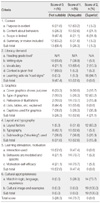Abstract
Purpose
The aim of this study was to assess the suitability and readability of printed educational materials for patients with hypertension in Korea.
Methods
A total of 33 written educational materials related to hypertension were collected from public health centers, hospitals, and internet web site. Among them, we analyzed 19 materials which fit the inclusion criteria: leaflets (n=9), booklets (n=3), and guide book (n=7). Two trained nurses evaluate the materials using suitability assessment tool (SAM; Doak, Doak, & Root, 1996a) and graded lexical items for teaching Korean (Kim, 2003).
References
1. Bernier MJ, Yasko J. Designing and evaluating printed education materials: Model and instrument development. Patient Education and Counselling. 1991. 18:253–263. doi:10.1016/0738-3991(91)90134-q.
2. Bodenheimer T, Lorig K, Holman H, Grumbach K. Patient self-management of chronic disease in primary care. Journal of the American Medical Association. 2002. 288:2469–2475. doi:10.1001/jama.288.19.2469.
3. Choe IS. A comparative study on modelling readability formulas: Focus on primary and secondary textbooks. Journal of Korean Society of Information Management. 2005. 22:173–195. doi:10.3743/KOSIM.2005.22.4.173.
4. Doak CC, Doak LG, Root JH. Teaching patients with low literacy skills. 1996a. 2nd ed. Philadelphia, PA: JB Lippincott Company.
5. Doak LG, Doak CC, Meade CD. Strategies to improve cancer education materials. Oncology Nursing Forum. 1996b. 23:1305–1312.
6. Flesch R. A new readability yardstick. Journal of Applied Psychology. 1948. 32:221–233. doi:10.1037/h0057532.
7. Fry E. A readability formula that saves time. Journal of Reading. 1968. 11:513–578.
8. Helen O. Health literacy from A to Z: Practical ways to communicate your health. 2004. Boston, MA: Jones and Bartlett Publishers.
9. Hoffmann T, Worrall L. Designing effective written health education materials: Considerations for health professionals. Disability and Rehabilitation. 2004. 26:1166–1173. doi:10.1080/09638280410001724816.
10. Kim GH. The graded lexical items for teaching Korean. 2003. Seoul: PJ book.
11. Kim SY, Park YW, Shin HC, Kim CH, Sung EJ, Lee SH. Readability of patient information on hypertension in Korea. Journal of the Korean Academy of Family Medicine. 2007. 28:346–351.
12. Korean thesaurus. Korean Language Education Research Institute. 2009. Retrieved October 19, 2009. from http://www.natmal.com.
13. Lee KW. Rho MW, Park YM, editors. Understanding comprehension process and communication of context. Literacy Education. 2008. Seoul: Hankukmunhwasa;332–354.
14. McLaughlin GH. SMOG grading a new readability formula. Journal of Reading. 1969. 12:639–646.
15. National Institute of the Korean Language. Literacy in Korea (No. 2008-1-57). 2008. Seoul: Author.
16. Standard Korean language dictionary. National Institute of the Korean Language. 2009. Retrieved September 5, 2009. from http://stdweb2.korean.go.kr.
17. Park SM, Jung HS, Kim YK, Lee YJ. Study on the way of the occupational health care management for foreign workers. 2007. Seoul: Federation of Korean Trade Union.
18. Park SY. Comparison of readabilities of 6th grade science and social studies textbook. 2009. Jeonju: Jeonju National University of Education;Unpublished master's thesis.
19. Scott A. Managing anxiety in ICU patients: The role of pre-operative information provision. Nursing in Critical Care. 2004. 9:72–79. doi:10.1111/j.1478-5153.2004.00053.x.
20. Seol DH, Hong SK, Goh HU, Kim IT. A research on the health care of foreign workers. 2005. Seoul: Korea Foundation for International Healthcare.
21. Shieh C, Hosie B. Printed health information materials; Evaluation of readability and suitability. Journal of Community Health Nursing. 2008. 25:73–90. doi:10.1080/07370010802017083.
22. Shin HC. The evaluation of patient educational materials. Journal of the Korean Academy of Family Medicine. 2000. 21:S318–S321.
23. Song JM. A study on the readability of elementary school science textbooks. 2010. Jeonju: Jeonju National University of Education;Unpublished master's thesis.
24. Sung NJ, Lee DU, Park KH. Suitability assessment of patient's education materials made by Korean academy of family medicine. Journal of the Korean Academy of Family Medicine. 2004. 25:669–677.
25. Literacy and health outcomes (AHRQ publication No. 04-E007-2). U.S. Department of Health and Human Service, Agency for Healthcare Research and Quality. 2004. Retrieved September 9, 2009. from http://www.ncbi.nlm.nih.gov/books/NBK37134.
26. Health literacy universal precautions toolkit (AHRQ publication No. 10-0046-EF). U.S. Department of Health and Human Service, Agency for Healthcare Research and Quality. 2010. Retrieved April 4, 2010. from http://www.ahrq.gov/qual/literacy.
27. Vallance JK, Taylor LM, Lavallee C. Suitability and readability assessment of educational print resources related to physical activity: Implications and recommendations for practice. Patient Education and Counseling. 2008. 72:342–349. doi:10.1016/j.pec.2008.03.010.
28. Wilson F, Brwon DL, Stephen-Ferris M. Can easy-to-read immunization information increase knowledge in urban low-income mothers? Journal of Pediatric Nursing. 2006. 21:4–12. doi:10.1016/j.pedn.2005.06.003.
29. Yoo HR. Readability of printed educational materials used to inform computer tomography. Journal of Korean Community Nursing. 2001. 12:670–679.
30. Yoon CW. The study on the Korean readability formula in non-literacy text. 2006. Cheongwon: Korea National University of Education;Unpublished master's thesis.




 PDF
PDF ePub
ePub Citation
Citation Print
Print






 XML Download
XML Download